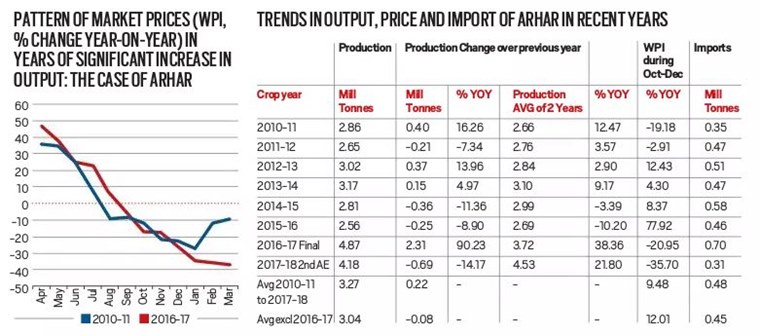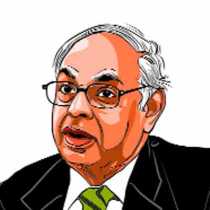Supporting farmers, the middle way
Under a limited procurement system, government would procure excess farm produce and leave rest to be cleared at market price. For it to work, MSP must not be at a level to which market price will not rise.

The effectiveness of the limited procurement system would depend on several factors. The timing and speed with which the procurement is implemented are critical. (Illustration by C R Sasikumar and Sarfaraz Alam)
Recently, there has been an active discussion on the strategies for raising farm output by providing remunerative prices to agricultural products. Over the years, between the price and non-price factors, on balance, the latter has been seen as more effective. However, our experience also shows that the price environment cannot be ignored.
When output increases well beyond the market demand at a price remunerative to producers, market prices decline and in the absence of effective price support policy, farmers are faced with a loss of income, depending on how much the price decline is. The “farm distress” in recent years has been partly on account of this situation, as the loss of income is beyond the ability of the small farmers to absorb.
A few schemes have been suggested to address the problem of managing declining output prices when output increases significantly. The effectiveness of a price support mechanism such as the Minimum Support Price (MSP) for addressing price decline would depend on how effective the system is for managing the supply-demand imbalances. The scheme of “price deficiency compensation”, which amounts to paying the difference between the market price and MSP, has gained acceptance in states such as Madhya Pradesh, Rajasthan and Haryana.
At the other extreme is the “open procurement system”, that has been in vogue quite effectively in the case of rice and wheat, where procurement is open-ended at the MSP. This scheme, however, poses the challenge of managing the distribution of the procured grain. Is there a middle way that may be effective in some crops, such as pulses? We consider the option of limited procurement for price stabilisation, a suggestion we have made earlier. We illustrate the scheme in the context of pulses.
The experience of 2016-17 in the case of pulses points to the huge impact on prices when the output grows significantly and suddenly. Actually, in the two years of 2010-11 and 2016-17, when output increased by 16 per cent and 90 per cent over the previous year, respectively, the prices fell sharply when the supplies began to arrive in the market (see figure).
In 2016-17, the output of arhar nearly doubled; increasing from 2.56 million tonnes in 2015-16, which was a bad year, to 4.87 million tonnes in 2016-17. During October-December, when the output of kharif crops reached the markets, prices fell by about 20 per cent in 2017 over the previous year. The price decline was not limited to just one year: The price fell by another 35 per cent in 2017-18 even though output could not be sustained at the 2016-17 level.
One contributing factor to the continued decline in prices in 2017-18 may have been the high level of imports during 2016-17, besides the surge in output. Imports perhaps were planned keeping in view the general deficit in supplies relative to demand. This argument does not change, even if we look not at the year-to-year change in output, but the change in the average of the current year and the preceding year. A similar behaviour is noticed in 2010-11 as well. The details of year-to-year trends in output and prices are provided in the table.

The “price deficiency” scheme may compensate the farmers when prices decrease below a certain specified level. However, the market prices may continue to fall as the supply exceeds the “normal demand”. Nearly all the produce may become eligible for the “deficiency payments” in theory as the prices, in general, would have fallen for all the producers. An alternative is the limited procurement scheme. Under this scheme, the government will procure the “excess”, leaving the normal production level to clear the market at a remunerative price. Thus, procurement will continue until the market price rises to touch the MSP.
The effectiveness of the limited procurement system would depend on several factors. The timing and speed with which the procurement is implemented are critical. It is important to determine the excess supply, which will indicate how much is to be procured. Therefore, an assessment of the likely production is essential for an effective market intervention. Equally important is the quick assessment of price trends, particularly in the period immediately after the harvest begins, to arrive in the key markets. In any case, the idea is not to absorb all the output but a quantity that would keep the supply-demand balance at the trend level.
The effectiveness of the system would also depend on how “distribution” of the procured grain is managed. Selling the procured grain back in the market in the same season would clearly defeat the purpose. Storage facilities for managing the procured grain are essential for the success of the system. Year-to-year fluctuations in production present opportunities to “distribute” the procured grain without impacting the market prices significantly.
The suggested “limited procurement system” will not work if the MSP is fixed at a level to which the market price will never rise.
It is not expected that the price stabilisation policy will continue indefinitely, especially in the case of commodities whose production needs to increase for a variety of reasons as in the case of pulses. A limited procurement option is necessary only in times of a sharp increase in production.
Rangarajan is former governor, Reserve Bank of India and Bhide is director, Madras Institute of Development Studies.
For all the latest Opinion News, download Indian Express App
More From C Rangarajan
1991’s golden transaction
How deep is India’s poverty?
GST, by other means
Pledging gold made everyone aware of the enormity of the crisis, and paved the way for economic reforms...
India’s poor are closely bunched up near the poverty line. This could make poverty alleviation more manageable...
A full-fledged GST will take time in the present political environment. But the Union government can begin by transforming its own indirect taxes into a…






































No hay comentarios:
Publicar un comentario